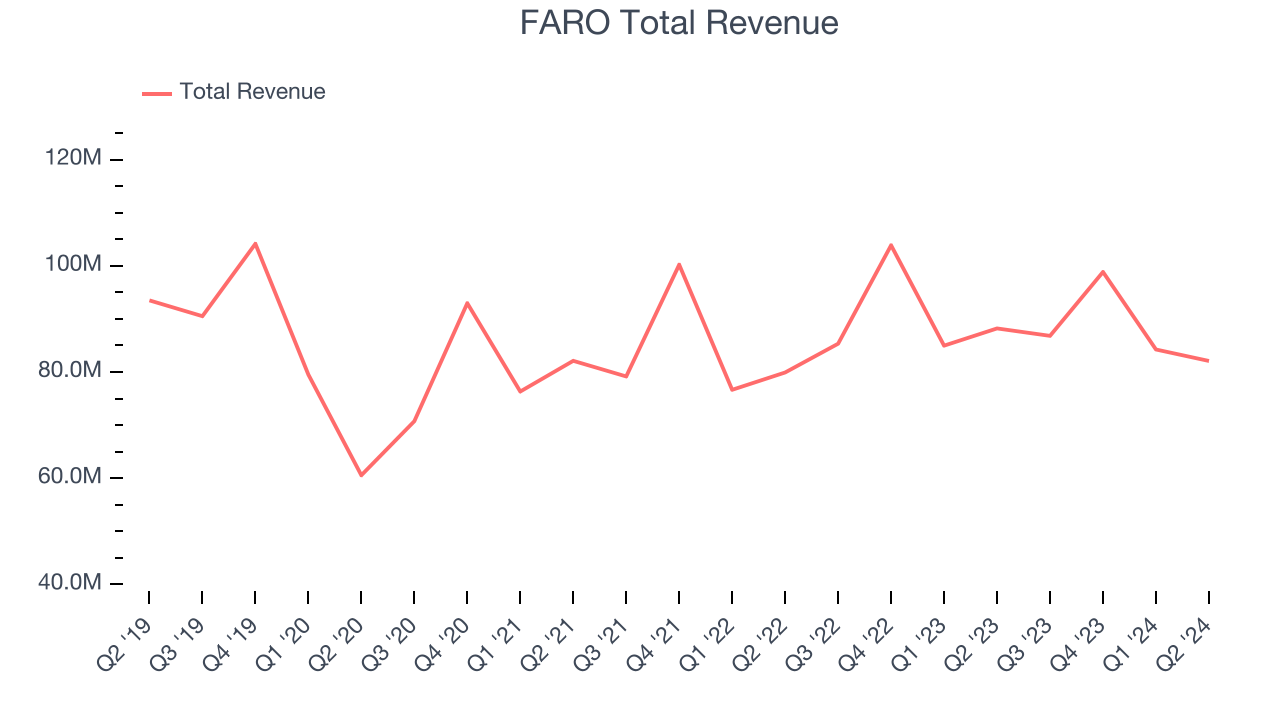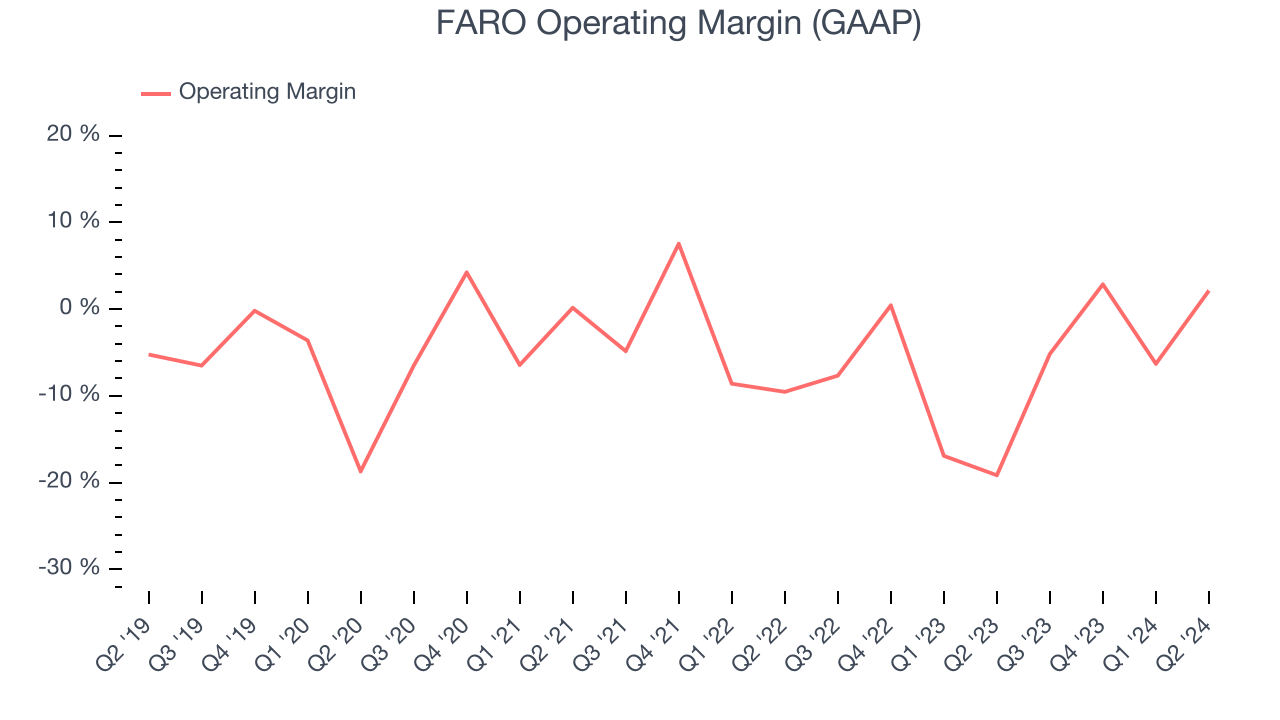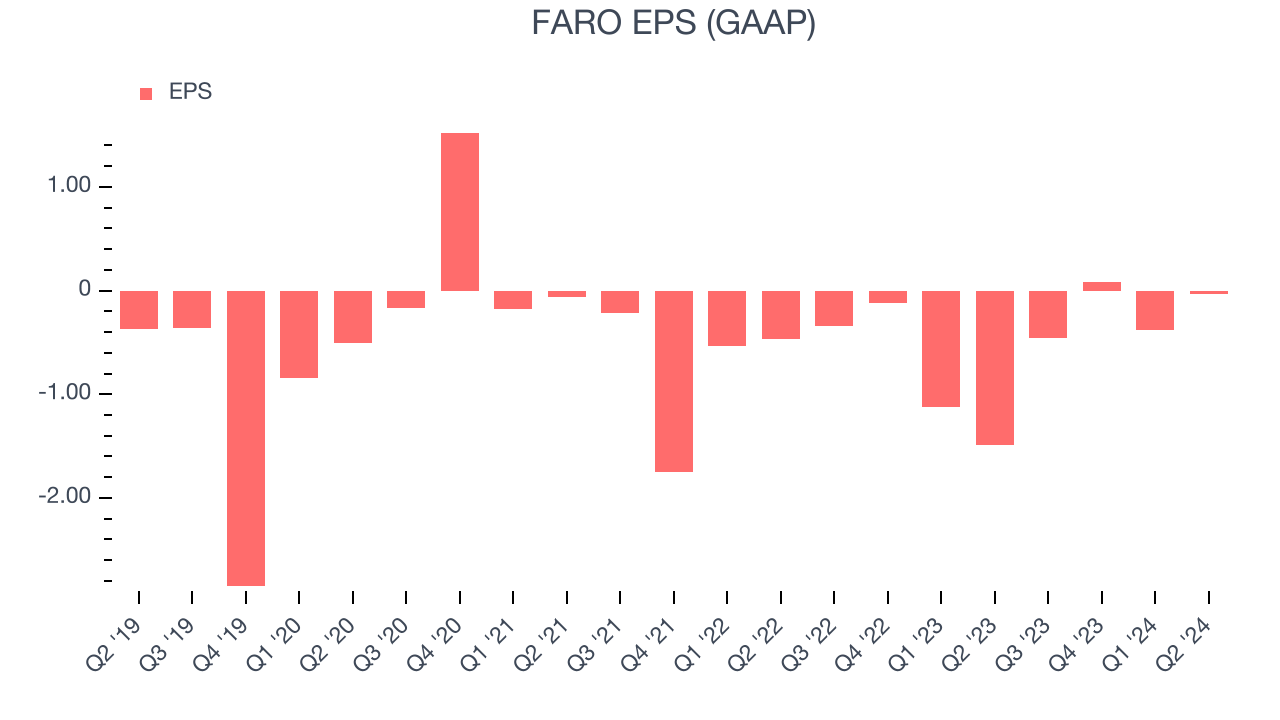3D measurement and imaging company FARO (NASDAQGS:FARO) fell short of analysts' expectations in Q2 CY2024, with revenue down 6.9% year on year to $82.09 million. Next quarter's revenue guidance of $80 million also underwhelmed, coming in 4.3% below analysts' estimates. It made a GAAP loss of $0.03 per share, improving from its loss of $1.49 per share in the same quarter last year.
Is now the time to buy FARO? Find out by accessing our full research report, it's free.
FARO (FARO) Q2 CY2024 Highlights:
- Revenue: $82.09 million vs analyst estimates of $83.65 million (1.9% miss)
- EPS: -$0.03 vs analyst estimates of -$0.35 ($0.31 beat)
- Revenue Guidance for Q3 CY2024 is $80 million at the midpoint, below analyst estimates of $83.61 million
- Gross Margin (GAAP): 54.6%, up from 37.8% in the same quarter last year
- EBITDA Margin: 10.3%, up from -15.2% in the same quarter last year
- Free Cash Flow of $3.85 million, down 26.8% from the previous quarter
- Market Capitalization: $272.1 million
"As I reflect on the completion of my first year at FARO, I am pleased with the execution of the first phase of our journey to drive operational excellence and we are pacing well ahead of our expectations," said Peter Lau, President & Chief Executive Officer.
Launched by two PhD students in a garage, FARO (NASDAQGS:FARO) provides 3D measurement and imaging systems for the manufacturing, construction, engineering, and public safety industries.
Inspection Instruments
Measurement and inspection instrument companies may enjoy more steady demand because products such as water meters are non-discretionary and mandated for replacement at predictable intervals. In the last decade, digitization and data collection have driven innovation in the space, leading to incremental sales. But like the broader industrials sector, measurement and inspection instrument companies are at the whim of economic cycles. Interest rates, for example, can greatly impact civil, commercial, and residential construction projects that drive demand.
Sales Growth
Reviewing a company's long-term performance can reveal insights into its business quality. Any business can have short-term success, but a top-tier one tends to sustain growth for years. FARO's demand was weak over the last five years as its sales fell by 2.4% annually, a rough starting point for our analysis. 
Long-term growth is the most important, but within industrials, a half-decade historical view may miss new industry trends or demand cycles. FARO's annualized revenue growth of 2.4% over the last two years is above its five-year trend, but we were still disappointed by the results.
This quarter, FARO missed Wall Street's estimates and reported a rather uninspiring 6.9% year-on-year revenue decline, generating $82.09 million of revenue. The company is guiding for a 7.8% year-on-year revenue decline next quarter to $80 million, a reversal from the 1.7% year-on-year increase it recorded in the same quarter last year. Looking ahead, Wall Street expects sales to grow 5.2% over the next 12 months, an acceleration from this quarter.
Here at StockStory, we certainly understand the potential of thematic investing. Diverse winners from Microsoft (MSFT) to Alphabet (GOOG), Coca-Cola (KO) to Monster Beverage (MNST) could all have been identified as promising growth stories with a megatrend driving the growth. So, in that spirit, we’ve identified a relatively under-the-radar profitable growth stock benefitting from the rise of AI, available to you FREE via this link.
Operating Margin
Operating margin is one of the best measures of profitability because it tells us how much money a company takes home after procuring and manufacturing its products, marketing and selling them, and, most importantly, keeping them relevant through research and development.
Although FARO was profitable this quarter from an operational perspective, it's generally struggled over a longer time period. Its expensive cost structure has contributed to an average operating margin of negative 4.6% over the last five years. Unprofitable industrials companies require extra attention because they could get caught swimming naked when the tide goes out. It's hard to trust that FARO can endure a full cycle.
On the bright side, FARO's annual operating margin rose by 4.6 percentage points over the last five years. Still, it will take much more for the company to show consistent profitability.

In Q2, FARO generated an operating profit margin of 2.1%, up 21.3 percentage points year on year. This increase was solid, and since the company's operating margin rose more than its gross margin, we can infer it was recently more efficient with expenses such as sales, marketing, R&D, and administrative overhead.
EPS
We track the long-term growth in earnings per share (EPS) for the same reason as long-term revenue growth. Compared to revenue, however, EPS highlights whether a company's growth was profitable.
FARO's earnings losses deepened over the last five years as its EPS dropped 64.7% annually. We tend to steer our readers away from companies with falling EPS, where diminishing earnings could imply changing secular trends and preferences. If the tide turns unexpectedly, FARO's low margin of safety could leave its stock price susceptible to large downswings.

In Q2, FARO reported EPS at negative $0.03, up from negative $1.49 in the same quarter last year. This print easily cleared analysts' estimates, and shareholders should be content with the results. Over the next 12 months, Wall Street is optimistic. Analysts are projecting FARO's EPS of negative $0.80 in the last year to reach break even.
Key Takeaways from FARO's Q2 Results
We liked that FARO beat analysts' EPS expectations this quarter. On the other hand, its revenue unfortunately missed and its revenue guidance for next quarter fell short of Wall Street's estimates. The revenue miss and weak outlook are weighing heavily on shares. The stock traded down 17.1% to $11.96 immediately following the results.
FARO may have had a tough quarter, but does that actually create an opportunity to invest right now? When making that decision, it's important to consider its valuation, business qualities, as well as what has happened in the latest quarter. We cover that in our actionable full research report which you can read here, it's free.
